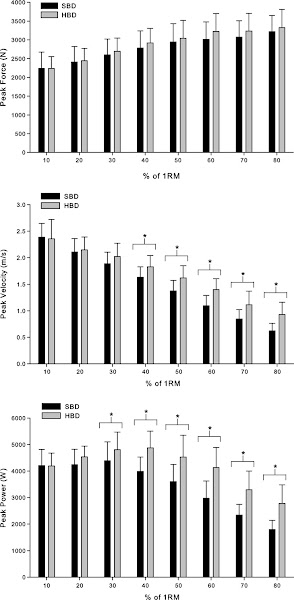One of the things that drives me crazy is the misinterpretation of research results. I have often seen this in the case of measuring physics outputs like force, impulse, or power. The exploration into deadlift variations has generated one such misinterpretation.
The increasingly wide spread use of hex bar deadlift has sparked a fair amount of debate on whether or not it is superior to straight bar deadlift. Research done comparing the two versions has shown consistent results. The hex bar involves more knee loading and less hip and spine loading and as a result uses the quads more and uses the posterior chain less than the straight bar deadlift. Lifters also tend to push greater force and power into the ground in hex bar deadlift.
The image below is from A Biomechanical Analysis of Straight and Hexagonal Barbell Deadlifts Using Submaximal Loads. The gray bars represent the measurements on the hex bar. The black bars are for the straight bar. You can see the peak power, force, and velocity tend to be higher with the hex bar. Results like this lead some people to conclude that hex bar is the superior deadlift for athletic development. Is this a sensible conclusion?
My response is that these force and power numbers do not matter. Getting high ground reaction forces is not the purpose of deadlift. You could do tuck jumps on a force plate and produce far greater force and power than any version of deadlift. Does that mean tuck jumps are a better exercise for athletes? No, they're just different. All strength exercises involve relatively low ground reaction forces, because we train strength by getting into biomechanically weak positions and lifting out of them. In weak positions we produce a lot of muscle tension but not especially high force into the ground. In the case of deadlift, the hex bar puts the body in a slightly stronger position, so the forces tend to be a little higher, but that is not a meaningful difference. The purpose of a strength exercise is high muscle tension and high neural drive, not high ground reaction force. Now if you perform the exact same movement with the exact same load and produce greater force or power than before, that is an indication of increased ability. That is meaningful. But one movement producing different physics outputs than another movement is irrelevant.
Another way to get higher force and power output in a deadlift is to raise the starting point of the weight. Making the lifter bend down less keeps him or her in a stronger position. So partial range of motion pulls also yield higher force and power outputs. Does this mean high rack pulls are better than pulls from the ground? Absolutely not. It's just a stronger position producing greater outputs. This does not determine the effectiveness of the exercise.
The correct question to ask is, "What is the stimulus on the body?" In the case of hex bar and straight bar deadlift, both are concentric lifts from the floor. Both use knee and hip extension, but hex bar is a little less hip dominant. So if you want the lift to be more hip dominant, use straight bar deadlift. If not, use hex bar. It's that simple.

